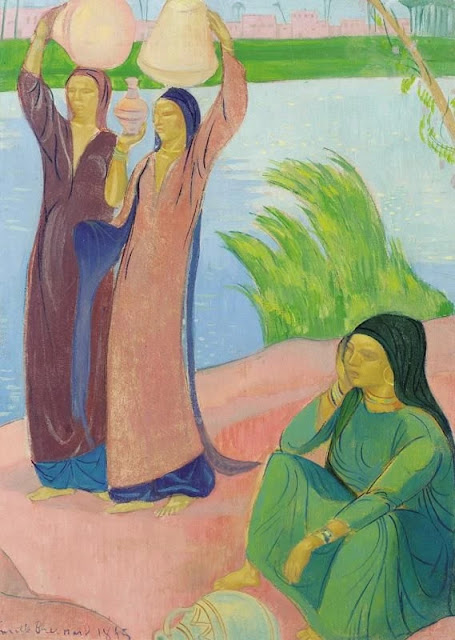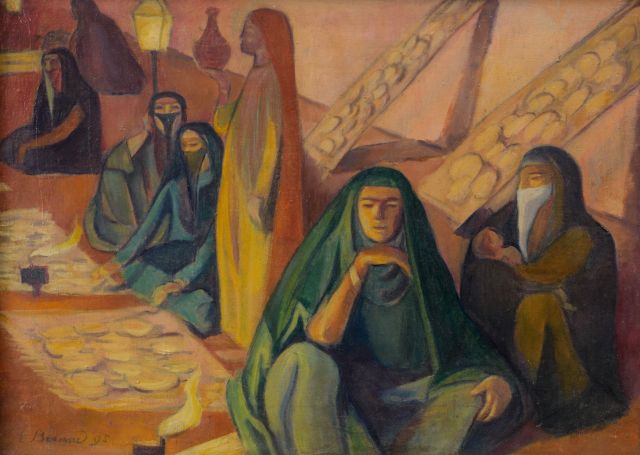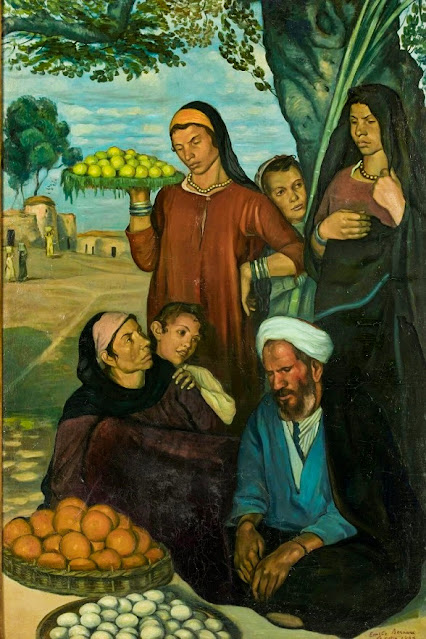
Émile Henri Bernard
A Seated Oriental Beauty
Oil on canvas
39¾ x 38 in. (101 x 96.5 cm.)
Private collection
Sold for USD 42,000 in Apr 2007
A strong light illumines the figure, reducing the background to a dark plane and yet does not diminish the sense of real dimension. The figure has a certain dignity in countenance, unlike the languid and coy expressions of many other Orientalist models. Bernard conveys his deep visual interest in the subject, carefully recording the items surrounding her. Such objects he would have seen on his travels through Tunisia and Egypt: rosewood clogs inlaid with mother-of-pearl, an ivory fan, gold necklaces and clustered bracelets, a carved-wood Moresque table and a variety of rich fabrics. Bernard's virtuosity is demonstrated in the rendering of silk in the figure's North African dress as well as the model's legs which are expertly painted to show through the sheer material while maintaining her modest beauty. More on this painting
Émile Henri Bernard
Oil on canvas
177.5 x 95 cm. (69.9 x 37.4 in.)
Private collection
Émile Henri Bernard
EGYPTIENNE ACCROUPIE/ CROUCHING Egyptian, c. 1895
Oil on canvas
65 x 81 cm. (25.6 x 31.9 in.)
Private collection
Emile Bernard
Vision of Egypt, c. 1898-1899
Oil on linen canvas
179 x 118 cm
Private collection
Émile Henri Bernard
Women on the banks of the Nile, c. 1900
Oil on canvas
height: 200cm; width: 300cm
Lille Palace of Fine Arts
Émile Henri Bernard
Femmes et enfants au bord du Nil, c. 1897
Oil on canvas
h: 180 w: 120 cm
Private collection
Émile Henri Bernard
Les porteuses d'eau/ The water carriers, c. 1894–1894
Oil on canvas
42.5 x 66 cm. (16.7 x 26 in.)
Private collection
Émile Henri Bernard
Water carriers, c. 1894
Oil on canvas
89 x 78 cm
Private collection
Émile Henri Bernard
THREE WOMEN BY THE RIVER
Oil on canvas
Private collection
Émile Henri Bernard
Bread sellers in Cairo or The market in Cairo, c. 1895
Oil on canvas
Height: 43 Width: 60 cm
Private collection
Émile Henri Bernard
Les Égyptiennes, c. 1895
Oil on canvas
50.2 x 61 cm
Private collection
Émile Henri Bernard
Marchands de fruits au Caire/ Fruit vendors in Cairo, c. 1897
Oil on canvas
h: 180 w: 120 cm
Private collection
Émile Henri Bernard
Egyptiennes, c. 1895
Oil on canvas
50 X 60 Cm
Private collection
Émile Henri Bernard
AU BORD DU NIL/ ON THE EDGE OF THE NILE, c. 1900
Oil on canvas
120 x 120 cm
Private collection
Émile Henri Bernard
Banks of the Nile at Marg, evening effect
Oil on canvas
55 x 44,5 cm ; 21 3/4 by 17 1/2 in
Private collection
El Marg is an administrative ward of Cairo, in the north-east of the Cairo Governorate,
Émile Henri Bernard
YOUNG WOMAN BREASTFEEDING, c. 1895
Oil on canvas
46.5 by 65cm
Private collection
Émile Henri Bernard
THE FELLAHS (THE EGYPTIAN TERRASSIERS; ARAB WORKERS, c. 1895
Oil on canvas
82 by 108.1cm., 32 1/4 by 42 1/2 in
Private collection
Émile Henri Bernard
Arab camp, Beduinlager , c. 1902
Oil on canvas
195 x 229 cm.
Private collection
Émile Henri Bernard
Baigneuses au Bord du Nil, 1893
Oil on canvas
86.5 x 66 cm
Private collection
Estimated for CHF 70,000 - CHF 90,000 in June 2017
This painting, which was created shortly after his arrival in Egypt, is a typical example of Bernard's work from that period. Androgynous water bearers and bathers on the banks of the Nile are nude, only adorned by bracelets and anklets, as he often depicted at the time. Presenting a strong contrast to this is a seated elderly woman dressed in black robes. She is likely a nun, as Bernard found shelter in a religious order during that time and later married a Syrian Christian. He was additionally fascinated by the contrasts and connections between nature and religion.
More on this painting
Émile Henri Bernard
Arab Festival, c. 1894
Oil on canvas
84 x 110 cm
Musée National des Arts d'Afrique et d'Océanie, Paris.
Émile Henri Bernard
Femmes fellahs au bain, c. 1900
Oil on wood pane
height: 175.7cm; width: 97.3cm
Musée des beaux arts de Reims
Painted in 1900, Femmes fellah au bain is a sort of synthesis between classical culture, to which he returned at that time, and his passion for the Orient. Indeed, Bernard uses large pink and green touches that he structures with a few superimposed white squares. This blurred and colorful style corresponds to his youthful plastic research and contrasts with the very naturalistic bodies of the three women in the foreground. The colors are warm but not flashy, the touch is long and quick, visible in places. The artist expresses in this work a sensual intimacy but without voyeurism. Seized at the time of their toilet, these women seem to be posing for the artist.
More on this painting
Émile Henri Bernard
The exotic dancer, c. 1915
Oil on canvas
128.6 x 80.7 cm
Private collection
This painting, his own Odalisque, features a level of naturalism that is quite new to Bernard's work but certainly in keeping with his determination to return to "tradition" and to reject emerging avant garde experimentation.
In this erotically-charged painting, the sensuous female figure, whose breasts are nearly completely exposed and who wears luxurious garments carefully described by Bernard and intended to read as "exotic," glances off to her right rather than meeting the gaze of the viewer. M
ore on this painting

Émile Henri Bernard
Danseuse nue/ Nude dancer, c. 1894
Oil on canvas
cm 150x94
Private collection
Sold for €4,000 EUR in June 2019
Emile Bernard Nude Dancing Girl with Henna Tatoos and bangles, a veiled woman sitting next to her, cloth, curtain and a vase nearby.
Émile Henri Bernard
Danseuse orientale/ Belly dancer
Oil on canvas
106 x 75 cm. (41.7 x 29.5 in.)
Private collection
Émile Henri Bernard
Danseuse des rues/ Street dancer, c. 1898
Oil on canvas
180 x 120 cm. (70.9 x 47.2 in.)
Private collection
Émile Henri Bernard
In the harem
Oil on board
42 x 29¾ in. (106 x 75.4 cm.)
Private collection
Émile Henri Bernard
AU HAREM
Oil on canvas
42 1/2 by 55 1/2 in. 108 by 141 cm
Private collection
Émile Henri Bernard's most formative artistic years were spent in the city of Paris where the Impressionist style had arisen and dominated the avant-garde scene into the 1880s. He immersed himself in the arts, attending exhibitions and visiting galleries and studying at the École des Arts Décoratifs beginning in 1884. He also trained at the well-respected Atelier Cormon, the studio of the artist and teacher, Fernand Cormon. There he met Henri de Toulouse-Lautrec, with him he formed a lasting friendship. Eventually, he was dismissed for "insubordinate behavior" and thus the radical young artist struck out on his own.
Bernard's close friendships with Paul Gauguin and Vincent van Gogh, two of the most influential artists of the Post-Impressionist period, proved fruitful in many ways, not least of which was the trio's intense co-experimentation; frequently, the produced works in identical themes and also made portraits of one another. Bernard maintained an extensive personal correspondence with Van Gogh and the letters they exchanged provide a unique window into the relationship. It is said that he was the first person to become aware of the importance of Van Gogh's work. Interestingly, Van Gogh's criticism of his work, particularly the biblical themes, prompted Bernard to end the correspondence. In the late 1880s, Bernard developed his unique Cloisonnist and Synthetist styles, which were extraordinarily influential for artists such as Gauguin, Anquetin, and Sérusier. More on Émile Henri Bernard
Please visit my other blogs: Art Collector, Mythology, Marine Art, Portrait of a Lady, The Orientalist, Art of the Nude and The Canals of Venice, Middle East Artists, 365 Saints, 365 Days, and Biblical Icons, also visit my Boards on Pinterest
Images are copyright of their respective owners, assignees or others.
Some Images may be subject to copyright
I don't own any of these images - credit is always given when due unless
it is unknown to me. if I post your images without your permission, please tell
me.
I do not sell art, art prints, framed posters or reproductions. Ads are
shown only to compensate the hosting expenses.
If you enjoyed this post, please share with friends and family.
Thank you for visiting my blog and also for liking its posts and pages.
Please note that the content of this post primarily consists of articles
available from Wikipedia or other free sources online.
















.jpg)










No comments:
Post a Comment